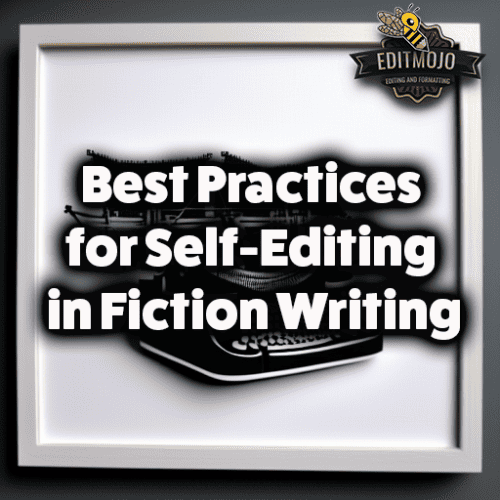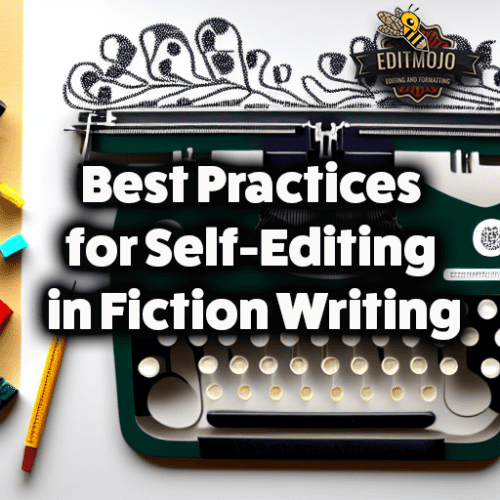Best practices for self-editing in fiction writing
Best practices for self-editing in fiction writing. Writing is an art, a craft that spins narratives out of nothingness. Yet, no first draft is ever a masterpiece. It’s in the forge of editing that raw ideas are honed into a sharp, captivating story. For most writers, the editing process starts at home, with self-editing. It’s a daunting task, fraught with challenges, but an absolutely necessary one. Today, we’ll delve into the nitty-gritty of self-editing and reveal the best practices to elevate your fiction writing.
Key Takeaway Table
| Key Sections | Key Takeaways |
|---|---|
| Understanding the Editing Process | Self-editing, beta reading, and professional editing are all distinct and necessary stages in the writing process. |
| Pre-Editing Considerations | Taking a break after the first draft and preparing your mindset and workspace are essential for successful self-editing. |
| Macro-Editing | Focusing on the story as a whole, assess your narrative structure, character development, and consistency in world-building. |
| Micro-Editing | Pay attention to the details, such as unnecessary words, sentence structure, dialogue authenticity, and grammar and punctuation. |
| Genre-Specific Editing | Understand and cater to the specific conventions and reader expectations of your genre. |
| Sensory and Emotional Editing | Enhance sensory details and emotional resonance to improve reader engagement and emotional impact. |
| Leveraging Technology in Self-Editing | Use editing tools like Grammarly, ProWritingAid, and Hemingway Editor as aids, but don’t over-rely on them. |
| Handling Feedback and Critique | Incorporate feedback from beta readers, but remember that the final decision on what to change is yours. |
| After Self-Editing: Next Steps | After self-editing, consider getting your manuscript reviewed by a professional editor. |
Understanding the Editing Process
The editing process in writing is akin to the carving process of a sculptor. It’s all about refining, removing, and reshaping until your work achieves its most powerful form. But it’s important to distinguish between self-editing, beta reading, and professional editing.
Self-editing is the process you undertake as the author to improve your own work. It’s a preliminary step, yet it helps in enhancing the overall structure, plot, characters, and language.
Beta reading, the second step, involves someone else reading your work to provide feedback from a reader’s perspective. It’s valuable in understanding how your intended audience might perceive your story.
Finally, there’s professional editing, where an experienced editor scrutinizes the manuscript for any errors or inconsistencies you might’ve overlooked.
Each of these stages has a distinct and necessary role in shaping the final manuscript, making your story the best version of itself.

Pre-Editing Considerations
Before you dive into editing, step back. Take a break after finishing the first draft. Your mind needs distance to gain fresh perspective and objectivity. It could be a few days or even a couple of weeks – whatever it takes to look at your work anew.
Get your mindset ready. Remember, self-editing is not about criticizing your work; it’s about improving it. It’s not about finding faults, but about finding opportunities to excel.
Organizing your workspace for optimal focus is equally essential. Ensure you have a quiet, comfortable space with minimal distractions. Set a regular editing schedule to maintain consistency.
First Round of Self-Editing: Macro-Editing
Think of Macro-editing as examining the forest rather than the individual trees. You’re looking at your story as a whole, assessing how all the pieces come together.
Start with the narrative structure. Does the plot make sense? Does the pacing feel right? Is the point of view consistent? For instance, J.K. Rowling’s Harry Potter series provides an excellent example of a well-structured plot, balanced pacing, and consistent point of view.
Next, turn to character development. Are your characters compelling and evolving? Have you fully explored their arcs? Just think of Katniss Everdeen from The Hunger Games. She starts as a resourceful girl merely surviving, and evolves into the face of a revolution.
Finally, scrutinize the consistency in your world-building and setting. Especially in genres like fantasy and sci-fi, a well-constructed and consistent world contributes significantly to reader engagement.

Second Round of Self-Editing: Micro-Editing
If Macro-editing is about the forest, Micro-editing is about the individual trees. It involves a closer look at your language and style.
Start by eliminating unnecessary words. Overuse of adverbs, filler words, or repetitive phrases can weaken your prose. In contrast, consider Hemingway’s work. His precise, frill-free style shows the power of simplicity.
Next, improve sentence structure and clarity. Are your sentences varied in length and structure? Are they clear and easy to understand? Is your word choice suitable for the context?
Moreover, check if your dialogues sound authentic and add to the plot. For example, George R.R. Martin’s A Song of Ice and Fire series is renowned for its engaging dialogues that bring characters to life and drive the plot.
Finally, correct any grammar and punctuation mistakes. This can be a bit tedious, but remember, nothing pulls a reader out of a story faster than a typo.
Special Consideration: Genre-Specific Editing
Each genre comes with its conventions and reader expectations. Understanding these can be critical to the editing process. For example, a mystery novel needs a well-constructed plot with clues subtly woven in, while a romance novel focuses on character chemistry and emotional depth.

Third Round of Self-Editing: Sensory and Emotional Editing
Here, you’ll enhance the sensory details and emotional resonance of your story.
First, focus on sensory details. Are you engaging all the reader’s senses to create vivid images? Consider Laura Esquivel’s “Like Water for Chocolate” for inspiration. The author masterfully uses sensory details to evoke taste and smell, making the food in the story almost tangible.
Next, assess the emotional impact of your story. Does it elicit the emotions you intend? Are the high and low emotional points paced correctly? Think of Nicholas Sparks’ novels, such as “The Notebook“, where emotional resonance is key.
Leveraging Technology in Self-Editing
Tools like Grammarly, ProWritingAid, and Hemingway Editor can be invaluable for spotting grammar errors, repetitive phrases, or complex sentences. However, remember, they’re tools to aid you, not replace you. They can catch mistakes, but the nuance of language and the human touch in a story can only be assessed by you.
Handling Feedback and Critique
Beta readers offer a fresh perspective on your story. Select your beta readers wisely – they should be people who enjoy your genre and can provide constructive feedback. Be open to their feedback, but also remember that it’s your story. You decide what advice to incorporate.
After Self-Editing: Next Steps
Once you’ve finished self-editing, consider your manuscript ready for a professional editor. They’ll bring their expertise to refine your manuscript further. Remember, even the best writers need editors. The query and publication process will also involve additional rounds of editing.
Conclusion (Best practices for self-editing in fiction writing)
Self-editing can feel like traversing a labyrinth, but with these guidelines, the path becomes clearer. It’s an opportunity for growth, to learn more about your craft, and to transform your manuscript into a work of art.
Lastly, remember that every writer’s process is unique. What matters most is finding what works best for you. Happy editing!
Additional Resources (Best practices for self-editing in fiction writing)
Here are some additional resources to help you on your self-editing journey:
- Editing tools: Grammarly, ProWritingAid, Hemingway Editor
- Books: Self-Editing for Fiction Writers by Renni Browne & Dave King, “The Story Grid” by Shawn Coyne.
Top Five Questions and Answers
| Questions | Answers |
|---|---|
| What is the role of self-editing in fiction writing? | Self-editing is a preliminary but essential step in the writing process where the author reviews and improves their own work before it is seen by others. |
| What is the difference between macro-editing and micro-editing? | Macro-editing involves looking at the story as a whole (plot, pacing, character development, etc.), while micro-editing involves focusing on the details (sentence structure, grammar, dialogue, etc.). |
| What are some effective strategies for genre-specific editing? | Effective strategies involve understanding the conventions and reader expectations specific to your genre and making sure your story aligns with them. |
| How can technology be used in the self-editing process? | Technology, such as editing tools like Grammarly, ProWritingAid, and Hemingway Editor, can be used to spot errors in grammar, sentence structure, punctuation, and other writing elements. |
| How should feedback from beta readers be handled? | Be open to their feedback, consider their perspectives, but remember that it’s your story. You decide what advice to incorporate. |
